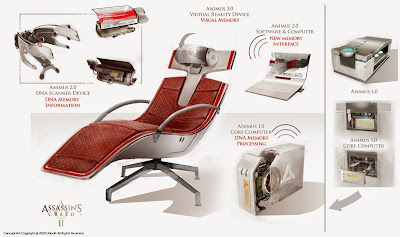"You're inside the Animus. It's a projector which renders genetic memories in three dimensions."
-Warren Vidic, Abstergo Industries scientist.
The Animus (plural: Animi) is a virtual reality machine rediscovered, developed, and sold by Abstergo Industries. It allows the user to read a subject's genetic memory, and project it onto an external screen in three dimensions.
The machine was notably used in Abstergo's Animus Project and the Animi Training Program. The former analyzed the genetic memories of several select subjects while the latter was used for the training of Abstergo employees.
The Animus was created by our company in the latter half of the 20th century. Dr. Warren Vidic's leading authority on genetic memory guided the machine's development and so he became the overseer of the Animus Project.
Animus 1.0
By 2002, Abstergo had also begun to produce Animi in greater numbers. Over the course of the next ten years, the appearance of the Animus only received minor updates. In 2012, the Animus had been updated to version 1.28, and was created to be more comfortable than previous models.
When in use, the Animus rotated a glass panel over the head of the user, on which the genetic memories being accessed were projected. The Animus 1.28 was not very energy-efficient, however, and was prone to overheating after extended use; upon overheating, the machine's blue lighting flashed orange instead.
Animus 2.0
The Animus 2.0 was different in many ways to the Animus 1.28, both physically and within the three-dimensional reality it projected. For example, the background color of the loading sequence changed from an icy blue to white, with the entire region of a memory slowly loading up each time one was accessed.[6]
The external properties of the Animus also changed greatly, with the 2.0 returning to a chair-like configuration, while offering increased comfort to the user. However, due to this, a catheter in the user's arm was required, in order to access genetic memories and link the user into the Animus itself. Despite these improvements, the Animus still suffered from lagged translation software, and was unable to prevent the Bleeding Effect over prolonged use.
Animus 3.0
The 3.0 upgrade was made in 2012, and was mainly a software upgrade which included a new user interface and changes to the puppeteering motion controls. However, the hardware of the Animus remained the same as before.
The Animus did go through cosmetic changes, though nothing drastically different from the Animus 2.0. The main difference was that the Animus equipment, namely the head and arm rests, no longer needed to be attached to a chair in order to function, meaning that the Animus could be set up on almost any flat surface. This made it much more portable.
Animus Omega
By late 2012, Animus and DDS technology had progressed to a point where it was possible to allow anybody to view the genetic memories of another individual, provided DNA was in storage.
Abstergo Entertainment utilized this technology by having consumers explore points of interest across history in order to obtain information, or to explore and upload their own genetic memories.
The Animus was available as a game console named Animus Omega, offering an interactive experience similar to our Animi Training Program, or as a visor, offering a heads-up display of how people or locations appeared in the past, enabling a person to identify someone they had not seen in years.
The Data Dump Scanner, more commonly referred to as the DDS, was the software that, in conjunction with the Animus, allowed the user to relive extracted memories. The DDS could allow the user to relive any pre-recorded memories, regardless of whether they were blood related, through uploading the extracted memories from another person's genetic memory.























0 comments:
Post a Comment